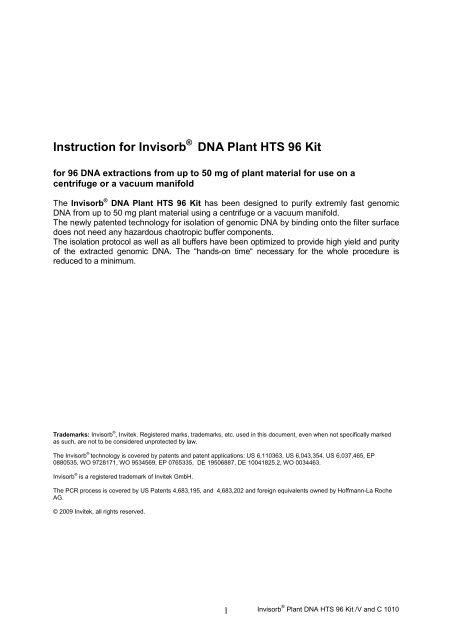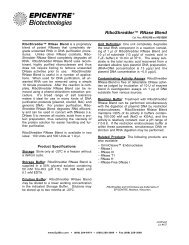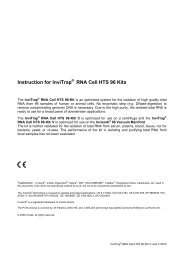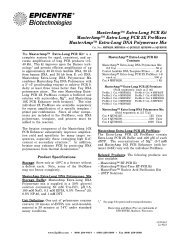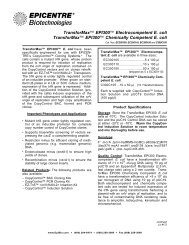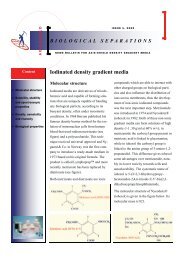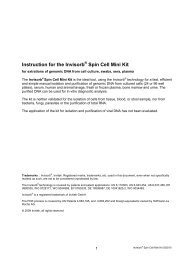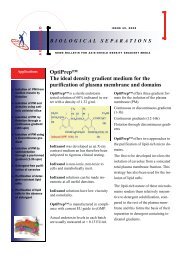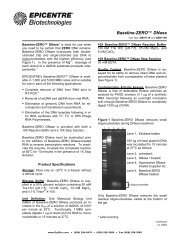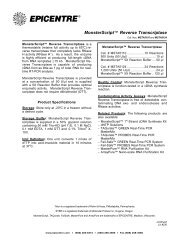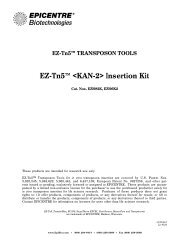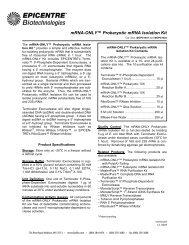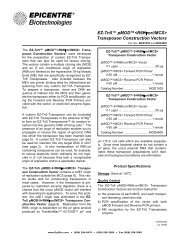DNA Plant HTS 96 Kit
DNA Plant HTS 96 Kit
DNA Plant HTS 96 Kit
Create successful ePaper yourself
Turn your PDF publications into a flip-book with our unique Google optimized e-Paper software.
Contents<strong>Kit</strong> content of Invisorb ® <strong>DNA</strong> <strong>Plant</strong> <strong>HTS</strong> <strong>96</strong> <strong>Kit</strong>/ C 3<strong>Kit</strong> content of Invisorb ® <strong>DNA</strong> <strong>Plant</strong> <strong>HTS</strong> <strong>96</strong> <strong>Kit</strong> V 4Safety information 5Product characteristic of the Invisorb ® <strong>DNA</strong> <strong>Plant</strong> <strong>HTS</strong> <strong>96</strong> <strong>Kit</strong> 6Yield and quality of genomic <strong>DNA</strong> 6Important points before starting a protocol 7Sampling and storage of starting material 7Preparing reagents and buffers 7Reagents and equipment to be supplied by user 7Principle and procedure 8Scheme of Invisorb ® <strong>DNA</strong> <strong>Plant</strong> <strong>HTS</strong> <strong>96</strong> <strong>Kit</strong>/ C 9Protocol: <strong>DNA</strong> extraction from plant material for use on a centrifuge 10Scheme of Invisorb ® <strong>DNA</strong> <strong>Plant</strong> <strong>HTS</strong> <strong>96</strong> <strong>Kit</strong>/ V 13Protocol : <strong>DNA</strong> extraction from plant material for use on aInvisorb ® <strong>96</strong> Vacuum Manifold 14Invisorb ® <strong>96</strong> Vacuum Manifold 15Troubleshooting 16Appendix 17Ordering information 18Invitek distributors 192Invisorb ® <strong>Plant</strong> <strong>DNA</strong> <strong>HTS</strong> <strong>96</strong> <strong>Kit</strong> /V and C 1010
<strong>Kit</strong> contents of Invisorb ® <strong>DNA</strong> <strong>Plant</strong> <strong>HTS</strong> <strong>96</strong> <strong>Kit</strong>/ CStore lyophilized Proteinase K at 2 - 8 °C. Store d iluted Proteinase K at -20 °C, but repeatedfreezing and thawing will reduced the activity dramatically.Dividing the Proteinase K into aliquots and storage at -20°C is recommended.Store all other kit components at room temperature (RT)!2 x <strong>96</strong> <strong>DNA</strong> extractions 4 x <strong>96</strong> <strong>DNA</strong> extractions 24 x <strong>96</strong> <strong>DNA</strong> extractionsCatalog No. 7037300200 7037300300 7037300400Lysis Buffer P 2 x 40 ml 4 x 40 ml 24 x 40 mlBinding Buffer P 80 ml 160 ml 900 mlElution Buffer D 30 ml 2 x 30 ml 350 mlProteinase K 2 x 2 ml 4 x 2 ml 24 x 2 mlRNase A 2 x 4 ml 4 x 4 ml 24 x 4 mlWash Buffer I75 ml(final volume 150 ml)2 x 45 ml(final volume 2 x 150 ml)2 x 75 ml(final volume 2 x 150 ml)4 x 45 ml(final volume 4 x 150 ml)2 x 350 ml(final volume 700 ml)4 x 270 ml(final volume 900 ml)Wash Buffer IICollection Plate; 2 ml 4 2 x 4 12 x 4Collection Plate, 1 ml 2 4 6 x 4Prefilter Plate 2 2 x 2 6 x 4<strong>DNA</strong> Binding Plate C 2 4 6 x 4Plate Lid 4 8 48Sealing Foils 2 4 24Manual 1 1 1Initial steps Add 75 ml <strong>96</strong>-100%ethanol to the bottle WashBuffer IAdd 105 ml of <strong>96</strong>-100%ethanol to each bottleWash Buffer II, mix shortlyand keep the bottle alwaysfirmly closed!Add 2 ml ddH 2 O to eachtube Proteinase K, mixthoroughly and store at-20°C !Add 75 ml <strong>96</strong>-100%ethanol to each bottleWash Buffer IAdd 105 ml of <strong>96</strong>-100%ethanol to each bottleWash Buffer II, mix shortlyand keep the bottle alwaysfirmly closed!Add 2 ml ddH 2 O to eachtube Proteinase K, mixthoroughly and store at -20°C !Add 350 ml <strong>96</strong>-100%ethanol to each bottleWash Buffer IAdd 630 ml of <strong>96</strong>-100%ethanol to each bottleWash Buffer II, mix shortlyand keep the bottle alwaysfirmly closed!Add 2 ml ddH 2 O to eachtube Proteinase K, mixthoroughly and store at-20°C !3Invisorb ® <strong>Plant</strong> <strong>DNA</strong> <strong>HTS</strong> <strong>96</strong> <strong>Kit</strong> /V and C 1010
Safety InformationWhen working with chemicals, always wear a suitable lab coat, disposable gloves andprotective goggles. Heed the legal requirements for working with biological material!For more information, please consult the appropriate material safety data sheets (MSDS).They are available online in convenient and compact PDF format at www.invitek.de undereach Invitek kit and whose kit component.If the buffer bottles are damaged or leaking, wear gloves and protective goggles whendiscarding the bottles in order to avoid any injuries.Invitek has not tested the liquid waste generated by the Invisorb ® <strong>DNA</strong> <strong>Plant</strong> <strong>HTS</strong> <strong>96</strong> <strong>Kit</strong>procedures for residual infectious materials. Contamination of the liquid waste with residualinfectious materials is highly unlikely, but cannot be exclude completely. Therefore, liquidwaste have be considered infectious and be handled and discarded according to local safetyregulation.Below European Community risk and safety phrases for the components of the Invisorb ® <strong>DNA</strong> <strong>Plant</strong><strong>HTS</strong> <strong>96</strong> <strong>Kit</strong> to which they apply, are listed.Lysis Buffer PProteinase KXiirritantR36 S24Binding Buffer PXnharmfulR36/37/38-42 S2-22-24-26-36/37Wash Buffer IXi; F contains 2-propanol Xnirritant; highly flammableharmfulR11-36-67 S7-16-24/25-26R20/21/22-32-52/53 S2-13-61R11: highly flammableR20/21/22: harmful by inhalation, in contact with skin and if swallowedR32: contact with acids liberates very toxic gasR36: irritating to eyesR36/37/38: irritating to eyes, respiratory system and skinR42: may cause sensitization by inhalation.R52/53: harmful to aquatic organisms, may cause long-term adverse effects in the aquatic environmentR67: vapours may cause drowsiness and dizzinessS2: keep out of the reach of childrenS7: keep container tightly closedS13: keep away from food, drink and animal feeding stuffsS16: keep away from sources of ignition - No smokingS22: do not breath dustS24/25: avoid contact with skin and eyesS24: avoid contact with skinS26: in case of contact with eyes, rinse immediately with plenty of water seek medical adviceS36/37: wear suitable protective clothing and glovesS61: avoid release to the environment. Refer to special instructions/safety data sheetEmergency medical information in English and German can be obtained 24 hours a day from:Poison Information Center Freiburg, Germany: Tel.: +49 761 192405Invisorb ® <strong>Plant</strong> <strong>DNA</strong> <strong>HTS</strong> <strong>96</strong> <strong>Kit</strong> /V and C 1010
Product Characteristic of the Invisorb ® <strong>DNA</strong> <strong>Plant</strong> <strong>HTS</strong> <strong>96</strong> <strong>Kit</strong>Starting material Yield Time Ratioup to 50 mg of a widevariety of plant speciesup to 6 µg/ wellabout 100 min (C)/about 120 min (V)inclusive 60 min incubationA 260 :A 2801.6-2.0The Invisorb ® <strong>DNA</strong> <strong>Plant</strong> <strong>HTS</strong> <strong>96</strong> <strong>Kit</strong> has been designed for a semi automated preparationof genomic <strong>DNA</strong> for up to 50 mg of plant sample in <strong>96</strong> well formatThe kit allows in combination with the Invisorb ® <strong>96</strong> Vacuum Manifold or a centrifuge aneasy handling and a highly efficient and reliable purification of highly purified genomic <strong>DNA</strong>.The kit composition of the Invisorb ® <strong>DNA</strong> <strong>Plant</strong> <strong>HTS</strong> <strong>96</strong> <strong>Kit</strong> is specially adapted for use in acentrifuge (marked with a C) or for the use on vacuum manifolds (marked with a V). Werecommend the use of the Invisorb ® <strong>96</strong> Vacuum Manifold.Due to the high purity, the isolated genomic <strong>DNA</strong> is ready to use for a broad panel ofdownstream applications:○○○○PCR*-ReactionsRFLP-AnalysisRestriction Enzyme DigestionHybridizationNo toxic or hazardous chemicals like chaotropic components are used.For the isolation of genomic <strong>DNA</strong> in high-through- put format, Invitek offers the Invisorb ®<strong>DNA</strong> <strong>Plant</strong> <strong>HTS</strong> <strong>96</strong> <strong>Kit</strong>s for use on different robotic stationsFor the isolation of <strong>DNA</strong> from single plant sample Invitek offers the Invisorb ® Spin <strong>Plant</strong> Mini<strong>Kit</strong> and the Invisorb ® Spin <strong>Plant</strong> Midi <strong>Kit</strong>.For further information please contact: Tel.: +49 (0) 30 9489 2894, 2910 in Germany andfrom foreign countries Tel.: +49 (0) 30 9489 2907 or your local distributor (see page 18).Yield and quality of genomic <strong>DNA</strong>The amount of purified <strong>DNA</strong> in the Invisorb ® <strong>DNA</strong> <strong>Plant</strong> <strong>HTS</strong> <strong>96</strong> <strong>Kit</strong> procedure from plantmaterial depends on sample source, transport conditions, storage and age of the sample.Yield and quality of isolated genomic <strong>DNA</strong> is suitable for any detection system.Important Indications for the Invisorb ® <strong>DNA</strong> <strong>Plant</strong> <strong>HTS</strong> <strong>96</strong> <strong>Kit</strong>The kit can also purify RNA besides <strong>DNA</strong>. For the elimination of RNA (if necessary) add 20 µlRNase A (10 mg/ ml) to Binding Buffer P in Tube A.Sampling and Storage of starting materialHarvested plant samples can be stored at room temperature for 2 – 3 hours, for short timestorage (up to one week) samples may be stored at 4°C. For long term storage, werecommend freezing samples at –20°C or –80°C. Multi ple thawing and freezing beforeisolating the <strong>DNA</strong> should be avoided.6Invisorb ® <strong>Plant</strong> <strong>DNA</strong> <strong>HTS</strong> <strong>96</strong> <strong>Kit</strong> /V and C 1010
Important points before starting a protocolAfter receiving the kit, check the kit components for damage. If buffer bottles are damaged,contact the Invitek Technical Services or your local distributor. In case of liquid spillage, referto “Safety Information” (page 6). Do not use damaged kit components, since their use maylead to poor kit performance.○○○○○○○always change pipet tips between liquid transfer. To avoid cross-contamination, werecommend the use of aerosol-barrier pipet tipsall centrifugation steps are carried out at room temperaturewhen working with chemicals, always wear a suitable lab coat, disposable gloves andprotective gogglesdiscard gloves if they become contaminateddo not combine components of different kits, unless the lot numbers are identicalavoid microbial contamination of the kit reagentsthis kit should only be used by trained personnelPreparing reagents and buffers1 x <strong>96</strong> <strong>DNA</strong>-extractions:Add 30 ml <strong>96</strong>-100% ethanol to the bottle Wash Buffer IAdd 105 ml of <strong>96</strong>-100% ethanol to the bottle Wash Buffer II, mix shortly and keep the bottle always firmly closed!Add 2 ml ddH 2O to the tube Proteinase K, mix thoroughly and store at -20°C !2 x <strong>96</strong> <strong>DNA</strong>-extractions:Add 75 ml <strong>96</strong>-100% ethanol to the bottle Wash Buffer IAdd 105 ml of <strong>96</strong>-100% ethanol to each bottle Wash Buffer II, mix shortly and keep the bottle always firmly closed!Add 2 ml ddH 2O to each tube Proteinase K, mix thoroughly and store at -20°C !4 x <strong>96</strong> <strong>DNA</strong>-extractions:Add 75 ml <strong>96</strong>-100% ethanol to each bottle Wash Buffer IAdd 105 ml of <strong>96</strong>-100% ethanol to each bottle Wash Buffer II, mix shortly and keep the bottle always firmly closed!Add 2 ml ddH 2O to each tube Proteinase K, mix thoroughly and store at -20°C24 x <strong>96</strong> <strong>DNA</strong>-extractions:Add 350 ml <strong>96</strong>-100% ethanol to each bottle Wash Buffer IAdd 630 ml of <strong>96</strong>-100% ethanol to each bottle Wash Buffer II, mix shortly and keep the bottle always firmly closed!Add 2 ml ddH 2O to each tube Proteinase K, mix thoroughly and store at -20°C !Reagents and equipment to be supplied by user○ multichannel pipet with tips○ reagents reservoirs for multichannel pipets○ centrifuge: output ≥ 2.000 x g is necessary○ Sigma-Centrifuge 4-15C or centrifuge 4K15C with plate-rotor 2 x <strong>96</strong> or otherrotors○ Eppendorf Centrifuge 5804 / 5804 R / 5810 / 5810 R with Deepwell-Plate-Rotor(A-2-DWP)○ Invisorb ® <strong>96</strong> Vacuum Manifold with waste tray and spacer○ Vacuum-source (at least 200 mbar or 150 mm Hg)○ ethanol (<strong>96</strong>-100%)○ Mixer Mill 300 and equipment from Qiagen*) The PCR method is covered by U.S. Patents 4,683,195 and 4,683,202 owned by Hoffmann-LaRoche Inc. The purchase of theInvisorb ® <strong>DNA</strong> <strong>Plant</strong> <strong>HTS</strong> <strong>96</strong> <strong>Kit</strong> cannot be construed as an authorization or implicit licence to practice PCR under any patentsheld by Hoffmann-LaRoche Inc.7Invisorb ® <strong>Plant</strong> <strong>DNA</strong> <strong>HTS</strong> <strong>96</strong> <strong>Kit</strong> /V and C 1010
Principle and procedureThe Invisorb ® <strong>DNA</strong> <strong>Plant</strong> <strong>HTS</strong> <strong>96</strong> <strong>Kit</strong> procedure comprises following steps:○○○○lysis of sample materialbinding the genomic <strong>DNA</strong> to the membranewashing and elimination of ethanolelution of genomic <strong>DNA</strong>After lysis the <strong>DNA</strong> binds to the membrane, contaminations and enzyme inhibitors areefficiently removed during the following three wash steps and highly purified <strong>DNA</strong> is eluted inElution Buffer or water.8Invisorb ® <strong>Plant</strong> <strong>DNA</strong> <strong>HTS</strong> <strong>96</strong> <strong>Kit</strong> /V and C 1010
Scheme Invisorb ® <strong>DNA</strong> <strong>Plant</strong> <strong>HTS</strong> <strong>96</strong> <strong>Kit</strong>/ CPlease read protocols prior the start of the preparation○○○○50 mg plant material into the QIAwell plate,homogenize with MixerMill MM 300 (Retsch) under liquid Nadd 400 µl Lysis Buffer P Mix (inclusive Proteinase K and RNaseA) to each well of the Qiawell plateIncubate at 65 °C for 60 min,centrifuge for 10 min at 1.700 x g (4.000 rpm)○○○○○transfer 350 µl of the lysate carefully from the QIAwell plate intothe wells of the Prefilter Plate.close the Prefilter Plate with a Plate Lidload the whole block (Prefilter Plate/ 2 ml Collection Plate) into theholder and place the whole assembly in the rotor bucket.centrifuge at 1.700 x g (4.000 rpm) for 5 mindiscard the Prefilter Plate○○○○○○add 350 µl Binding Buffer P to each well of the 2 ml CollectionPlateplace the <strong>DNA</strong> Binding Plate C on top of a new 2 ml Collection Plate.Transfer the suspension completely into each well of the <strong>DNA</strong>Binding Plate C.Close the <strong>DNA</strong> Binding Plate C with the Plate Lid and incubate for1 min at RTCentrifuge at 1.700 x g (4.000 rpm) for 10 min at RTRemove the Plate Lid and discard the filtrate.○○○add 500 µl Wash Buffer I to each well of <strong>DNA</strong> Binding Plate Dcentrifuge at 1.400 - 1.700 x g (3.700 – 4.000 rpm) for 5 min at RTRemove the Plate Lid and discard the filtrate○○○○○○○add 700 µl Wash Buffer II to each well of <strong>DNA</strong> Binding Plate Ccentrifuge at 1.700 x g (4.000 rpm) for 5 min at RTdiscard filtrate and place the <strong>DNA</strong> Binding Plate C back on the topof a 2 ml Collection PlateRepeat the wash stepremove all waste from the waste traycentrifuge at maximum speed for 15 min to dry the membranediscard 2 ml Collection Plate○○○○○○○place the <strong>DNA</strong> Binding Plate C on the top of a 1 ml CollectionPlate or of a Microtube Plateadd 60 µl Elution Buffer Dincubate 5 min at RT·centrifuge at 1.700 x g (4.000 rpm) for 5 minRepeat the elution stepTake the <strong>DNA</strong>-Binding Plate C and the 1 ml Collection Plate out ofthe centrifugeDiscard the <strong>DNA</strong>-Binding Plate C9Invisorb ® <strong>Plant</strong> <strong>DNA</strong> <strong>HTS</strong> <strong>96</strong> <strong>Kit</strong> /V and C 1010
Protocol : <strong>DNA</strong> extraction from plant material for use on a centrifugeAttention:The complete disruption and homogenization of the plant samples is absolute essential forisolation of high yield of genomic <strong>DNA</strong>. The disruption procedure, the breakage ofintercellular matrix and plasma membranes, is necessary to release the nucleic acidscontained in the plant cell, thus inefficient disruption decreases the <strong>DNA</strong> yield.The homogenization means the reduction of the viscosity of the lysate after disruption.Contaminating total RNA and other cellular components of high molecular weight are shearedto form a homogenous lysate. If the homogenization of the starting material is not done verycarefully the yield of genomic <strong>DNA</strong> purified is reduced significantly.It is possible to use a commercially available bead mill or rotor-stator homogenizer incombination with or without beads for the disruption and homogenization of the startingmaterial. Alternatively the starting material can reduced to a fine powder in liquid nitrogenusing a mortar and pestle.Rotor–stator homogenizers and bead mills simultaneously disrupt and homogenize the plantmaterial, whereas plant tissue are only disrupted using a mortar and pestle, and a separatehomogenization step should be performed.Note: Elution with prewarmed Elution Buffer D (up to 80 °C) will also increase the final yield.1. Disruption, Homogenization and Lysis of the plant material in a Mixer Mill* )Note:It’s recommended to use a mixer mill for the simultaneous homogenization of <strong>96</strong> plant samples.The Mixer Mill from Retsch, works in a <strong>96</strong>-well format, but only in combination with a specialadapter from Qiagen. Therefore the use of QIAwell plates (not provided) is necessary.Transfer up to 50 mg plant material into the QIAwell plate (not provided) and homogenizewith Mixer Mill MM 300 (Retsch) under liquid N 2 .Mix one bottle of Lysis Buffer P with one tube of Proteinase K and one bottle of RNase AAdd 400 µl Lysis Buffer P Mix (inclusive Proteinase K and RNase A) to each well of theQiawell plate .Incubate at 65 °C for 60 min, centrifuge for 10 min at 1.700 x g (4.000 rpm) .2. PrefiltrationPlace the Prefilter Plate on top of a 2 ml Collection Plate. Transfer 350 µl of the lysate carefullyfrom the QIAwell plate into the wells of the Prefilter Plate. Close the Prefilter Plate with aPlate Lid.Load the whole block (Prefilter Plate/ 2 ml Collection Plate) into the holder and place thewhole assembly in the rotor bucket. Centrifuge at 1.700 x g (4.000 rpm) at RT.Take the Prefilter Plate/ 2 ml Collection Plate out of the centrifuge. Remove the Plate Lid.Discard the Prefilter Plate.Note:You do not need to centrifuge, if the lysates have already run through the filter*) If a Mixer Mill is not available, a disruption and homogenization of the plant material must be performedwith other methods, like with mortar, pestle and N 2 or within another kind of mill (like Savant) with beads,or on a Gyrator (UniEquip) or using a rotor–stator homogenizer.10Invisorb ® <strong>Plant</strong> <strong>DNA</strong> <strong>HTS</strong> <strong>96</strong> <strong>Kit</strong> /V and C 1010
3. Binding of the genomic <strong>DNA</strong> to the <strong>DNA</strong> Binding Plate CAdd 350 µl Binding Buffer P to each well of the 2 ml Collection Plate and mix the solutionvery well by pipetting several times up and down by using a multichannel pipet.Place the <strong>DNA</strong> Binding Plate C on top of a new 2 ml Collection Plate. Transfer the suspensioncompletely into each well of the <strong>DNA</strong> Binding Plate C. Close the <strong>DNA</strong> Binding Plate C with thePlate Lid and incubate for 1 min at RT.Load the whole block (<strong>DNA</strong> Binding Plate C/ 2 ml Collection Plate) into the holder and place thewhole assembly in the rotor bucket. Centrifuge at 1.700 x g (4.000 rpm) for 10 min at RT.Take the <strong>DNA</strong> Binding Plate C/ 2 ml Collection Plate out of the centrifuge. Remove the Plate Lidand discard the filtrate.Place the <strong>DNA</strong> Binding Plate C back to the top of the 2 ml Collection Plate.4. First Washing of the <strong>DNA</strong> Binding Plate CAdd 500 µl Wash Buffer I to each well of the <strong>DNA</strong> Binding Plate C. Close the <strong>DNA</strong> BindingPlate C with the Plate Lid. Load the whole block (<strong>DNA</strong> Binding Plate C/ 2 ml Collection Plate)into the holder and place the whole assembly in the rotor bucket.Centrifuge at 1.700 x g (4.000 rpm) for 5 min at RT.Remove the Plate Lid and discard the filtrate.Place the <strong>DNA</strong> Binding Plate C back to the top of the 2 ml Collection Plate.5. Second washing of the <strong>DNA</strong>-Binding Plate CAdd 700 µl Wash Buffer II to each well of the <strong>DNA</strong> Binding Plate C. Close the <strong>DNA</strong> BindingPlate C with the Plate Lid. Load the whole block (<strong>DNA</strong> Binding Plate C / 2 ml Collection Plate)into the holder and place the whole assembly in the rotor bucket.Centrifuge at 1.700 x g (4.000 rpm) for 5 min at RT.Remove the Plate Lid and discard the filtrate.Place the <strong>DNA</strong> Binding Plate C back to the top of the 2 ml Collection Plate.Repeat this washing step6. Removing of ethanolTake the <strong>DNA</strong> Binding Plate C/ 2 ml Collection Plate out of the centrifuge. Remove the PlateLid. Place the <strong>DNA</strong> Binding Plate C onto a clean surface (paper towel). Empty the 2 mlCollection Plate and dry its upper side with paper.Place the <strong>DNA</strong> Binding Plate C on top of the 2 ml Collection Plate and close it with a Plate Lid.Load the whole block (<strong>DNA</strong> Binding Plate C/ 2 ml Collection Plate) into the holder and place thewhole assembly in the rotor bucket of the centrifuge.Centrifuge at maximum speed for at least 15 min at RT to eliminate any traces of ethanol.Take the <strong>DNA</strong> Binding Plate C/ 2 ml Collection Plate out of the centrifuge, discard the Plate Lidand place the plate on a clean paper towel.Discard the 2 ml Collection Plate.11Invisorb ® <strong>Plant</strong> <strong>DNA</strong> <strong>HTS</strong> <strong>96</strong> <strong>Kit</strong> /V and C 1010
7. Elution of the genomic <strong>DNA</strong>Place the <strong>DNA</strong> Binding Plate C on the top of a 1 ml Collection Plate.Add 60 µl Elution Buffer D directly onto the membrane in each well and incubate for 5 min.Close the <strong>DNA</strong> Binding Plate C with a new Plate Lid and place the whole block (<strong>DNA</strong> BindingPlate C/ 1 ml Collection Plate ) in the rotor bucket of the centrifuge.Centrifuge for 5 min at 1.700 x g (4.000 rpm)Remove the Plate Lid.Add 60 µl Elution Buffer D again directly onto the membrane in each well. Close the <strong>DNA</strong>Binding Plate C with the Plate Lid and place the whole block (<strong>DNA</strong> Binding Plate C/ 1 mlCollection Plate ) in the rotor bucket of the centrifuge. Centrifuge for 5 min at 1.700 x g (4.000rpm).Take the <strong>DNA</strong>-Binding Plate C and the 1 ml Collection Plate very carefully out of the centrifugein order to avoid cross-contaminations with adherent fluid.Discard the <strong>DNA</strong>-Binding Plate C.Take the 1.0 ml Collection Plate with the eluted <strong>DNA</strong> and cover the plate with sealing foil.12Invisorb ® <strong>Plant</strong> <strong>DNA</strong> <strong>HTS</strong> <strong>96</strong> <strong>Kit</strong> /V and C 1010
Scheme Invisorb ® <strong>DNA</strong> <strong>Plant</strong> <strong>HTS</strong> <strong>96</strong> <strong>Kit</strong>/VPlease read protocols prior the start of the preparation○ transfer up to 50 mg plant material into the Qiawell plate andhomogenize with Mixer Mill MM 300 (Retsch) under liquid N 2.○ add 400 µl Lysis Buffer P Mix (inclusive Proteinase K and RNase A)to each well of the Qiawell plate l○ Incubate at 65 °C for 60 min,○ centrifuge for 10 min at 1.700 x g (4.000 rpm)○○ Place the 1 ml Collection Plate in the base of the Invisorb ® <strong>96</strong>Vacuum Manifold○ Transfer 350 µl Lysate carefully from Qiawell plate into the wellsfrom the Prefilter Plate.○ Switch on vacuum source○○○add 350 µl Binding Buffer P to each well, mix completelyplace a waste tray in the base of the manifold, add the topplateplace the <strong>DNA</strong> Binding Plate C on the top of the manifold○Transfer the probes from 1 ml Collection Plate to the <strong>DNA</strong> BindingPlate C.○○○○○○○add 500 µl Wash Buffer I to each wellapply vacuum for 3 min or until all wash buffer was runningthroughadd 700 µl Wash Buffer II to each well of <strong>DNA</strong> BindingPlate Dapply vacuum for 3 minRepeat the wash stepremove all waste from the waste trayapply vacuum for 20 min to dry the membrane○ place the spacer in the manifold○ place than1 ml Collection Plate inside the base of themanifold, add the top plate○ place the <strong>DNA</strong> Binding Plate D on the top of the manifold○ add 60 µl Elution Buffer D per cavity○ incubate 5 min at RT○ apply vacuum for 52 min13Invisorb ® <strong>Plant</strong> <strong>DNA</strong> <strong>HTS</strong> <strong>96</strong> <strong>Kit</strong> /V and C 1010
Protocol :<strong>DNA</strong> extraction from plant material for use on a vacuummanifold1. Incubation of the plant material in Lysis Buffer PTransfer up to 50 mg plant material into the Qiawell plate and homogenize with Mixer Mill MM300 (Retsch) under liquid N 2 .Mix one bottle of Lysis Buffer P with one tube of Proteinase K and one bottle of RNase AAdd 400 µl Lysis Buffer P Mix (inclusive Proteinase K and RNase A) to each well of theQiawell plate .Incubate at 65 °C for 60 min, centrifuge for 10 min at 1.700 x g (4.000 rpm).2. PrefiltrationPlace the 1 ml Collection Plate in the base of the Invisorb ® <strong>96</strong> Vacuum Manifold and close themanifold with the top plate. Place the Prefilter Plate onto the rubber joint of the Invisorb ® <strong>96</strong>Vacuum Manifold top plate.Transfer 350 µl Lysate carefully from Qiawell plate into the wells from the Prefilter Plate.Switch on vacuum source and apply vacuum up to the lysates are running through the filtercompletely.Discard the Prefilter Plate. Take out the Adapter and the 1 ml Collection Plate from the vacuummanifold base.3. Binding of the genomic <strong>DNA</strong> to the <strong>DNA</strong> Binding Plate CAdd 350 µl Binding Buffer P to each well of the 1 ml Collection Plate and mix the solutionvery well by pipetting several times up and down by using a multichannel pipet.Place the waste tray into the base of the Invisorb ® <strong>96</strong> Vacuum Manifold and close the manifoldwith the top plate. Place the <strong>DNA</strong> Binding Plate C onto the rubber joint of the Invisorb ® <strong>96</strong>Vacuum Manifold top plate.Transfer the probes from 1 ml Collection Plate to the <strong>DNA</strong> Binding Plate C. Switch on vacuumsource and apply vacuum up to the lysates are running through the filter completely.4. First Washing of the <strong>DNA</strong> Binding Plate CAdd 500 µl Wash Buffer I to each well. Switch on vacuum source and apply vacuum until thetransfer of the wash buffer into the waste tray will be completed. Switch off vacuum and ventilatethe vacuum manifold.5. Second washing of the <strong>DNA</strong>-Binding Plate CAdd 700 µl Wash Buffer II to each well. Switch on vacuum source and apply vacuum until thetransfer of the wash buffer into the waste tray is complete. Switch off vacuum and ventilate thevacuum manifold.Repeat this washing step by adding again 700 µl Wash Buffer II to each well. Switch onvacuum source and apply vacuum until the transfer of the wash buffer is complete. Switch offvacuum and ventilate the vacuum manifold. To remove adherent fluid lift the <strong>DNA</strong>-Binding PlateC from the Invisorb ® <strong>96</strong> Vacuum Manifold top plate and strike the bottom side of the <strong>DNA</strong>-Binding Plate C on a stack of paper towels. Repeat several times until no further liquid isreleased onto the paper. Remove the manifold top plate from the base and discard the flowthroughfrom the waste tray.14Invisorb ® <strong>Plant</strong> <strong>DNA</strong> <strong>HTS</strong> <strong>96</strong> <strong>Kit</strong> /V and C 1010
6. Removing of ethanolPlace the waste tray inside the vacuum manifold and close the manifold with the top plate. Placethe <strong>DNA</strong> Binding Plate C onto the rubber joint of the Invisorb ® <strong>96</strong> Vacuum Manifold top plate.Switch on vacuum source and apply vacuum for at least 20 min for complete remove of allethanol. Switch off vacuum and ventilate the vacuum manifold. Take the <strong>DNA</strong> Binding Plate Cout of the manifold and place it on a clean paper towel. Remove the manifold top plate and thewaste tray from the base.7. Elution of the genomic <strong>DNA</strong>Place a new 1.0 ml Collection Plate inside the base of the Invisorb ® <strong>96</strong> Vacuum Manifold andclose the manifold with the top plate. Place the <strong>DNA</strong>-Binding Plate C onto the rubber joint of theInvisorb ® <strong>96</strong> Vacuum Manifold top plate. Add 60 µl Elution Buffer D directly onto themembrane in each well and incubate for 5 min. Switch on vacuum source and apply vacuumfor at least 5 min until the transfer into the wells of the 1.0 ml Collection Plate is complete. Add60 µl Elution Buffer D again directly onto the membrane in each well. Switch on vacuumsource and apply vacuum for at least 5 min until the transfer into the wells of the 1.0 mlCollection Plate is complete.To remove adherent drops from the outlets of the <strong>DNA</strong>-Binding Plate C strike several times withthe flat hand on the top of the plate. Switch off vacuum and ventilate the vacuum manifold. Takethe <strong>DNA</strong>-Binding Plate C very carefully out of the manifold in order to avoid crosscontaminationswith adherent fluid. Discard the <strong>DNA</strong>-Binding Plate C. Remove the manifold topplate from the base and take the 1.0 ml Collection Plate with the eluted <strong>DNA</strong> out of the manifold.Cover the plate with the sealing foil.Note: Elution with prewarmed Elution Buffer D (up to 80 °C) will increase also the final yield.Invisorb ® <strong>96</strong> Vacuum ManifoldThe Invisorb ® <strong>96</strong> Vacuum Manifold contains acrylglas. To avoid any problems with thematerial please note the following instruction:1. Avoid a long incubation with ethanol or Binding Buffer P containing solutions.2. Clean up the manifold after using with water immediately and dry it.3. Always use the waste tray.15Invisorb ® <strong>Plant</strong> <strong>DNA</strong> <strong>HTS</strong> <strong>96</strong> <strong>Kit</strong> /V and C 1010
TroubleshootingProblem/ probable causeComments and suggestionsclogged <strong>DNA</strong>-Binding Plateincomplete lysis of starting material/viscous lysatesvacuum to lowincrease incubation time with Lysis Buffer Preduce amount of starting materialIncrease the vacuum or prolong the vacuum timelow amounts or none <strong>DNA</strong>insufficient lysisincomplete elutionincrease time for lysisreduce amount of starting material or use highervolume of Lysis Buffer P. Increase Binding BufferP to adequate volume. Lysis Buffer P/ BindingBuffer P ratio has to be always 2/1make sure that the correct amount of ethanol isadded to the Wash Buffersmake sure that the Buffers are stored correctlyIncrease incubation time with prewarmed ElutionBuffer D to 10 min or repeat elution step once againprewarm Elution Buffer D up to 80°Cproblems with downstreamapplications(e.g. PCR)ethanol carryover during elutionsalt carryover during elutionincrease centrifugation time for removing of ethanolensure that Wash Buffer I and Wash Buffer II are atroom temperature. Check up Wash Buffers for saltprecipitates. If there are any precipitates solve theseprecipitates by careful warming16Invisorb ® <strong>Plant</strong> <strong>DNA</strong> <strong>HTS</strong> <strong>96</strong> <strong>Kit</strong> /V and C 1010
AppendixGeneral notes on handling <strong>DNA</strong>Nature of <strong>DNA</strong>The length and delicate physical nature of <strong>DNA</strong> requires careful handling to avoid damagedue to shearing and enzymatic degradation. Other conditions that affect the integrity andstability of <strong>DNA</strong> include acidic and alkaline environments, high temperature, and UVirradiation. Careful isolation and handling of high molecular weight <strong>DNA</strong> is necessary toensure compatibility with various downstream applications. Damaged <strong>DNA</strong> could performpoorly in applications such as genomic Southern blotting, long-template PCR.Storage of <strong>DNA</strong>A working stock of <strong>DNA</strong> can be stored at 2–4 °C for several weeks. For long term storage<strong>DNA</strong> should be stored at –20 °C, but storing at –20 °C can cause shearing, particularly if the<strong>DNA</strong> is exposed to repeated freeze-thaw cycles.Note that the solution in which the nucleic acid is eluted in will affect it’s stability duringstorage. Pure water lacks buffering capacity and an acidic pH may lead to acid hydrolysis.Tris or Tris-EDTA buffer contains sufficient buffering capacity to prevent acid hydrolysis.Drying, dissolving and pipetting <strong>DNA</strong>Avoid overdrying genomic <strong>DNA</strong> after ethanol precipitation. It is better to let it air dry than touse a vacuum, although vacuum drying can be used with caution.Avoid vigorous pipeting. Pipeting genomic <strong>DNA</strong> through small tip openings causes shearingor nicking. One way to decrease shearing of genomic <strong>DNA</strong> is to use special tips that havewide openings designed for pipeting genomic <strong>DNA</strong>.<strong>DNA</strong> YieldThe amount of purified <strong>DNA</strong> from the plant material depends on sample source, transportconditions, storage and age of the sample.17Invisorb ® <strong>Plant</strong> <strong>DNA</strong> <strong>HTS</strong> <strong>96</strong> <strong>Kit</strong> /V and C 1010
Order informationInviMag ® <strong>Plant</strong> <strong>DNA</strong> Mini <strong>Kit</strong>/ KFmL 2437110100 15 purificationsInviMag ® <strong>Plant</strong> <strong>DNA</strong> Mini <strong>Kit</strong>/ KFmL 2437110200 75 purificationsInviMag ® <strong>Plant</strong> <strong>DNA</strong> Mini <strong>Kit</strong>/ KF <strong>96</strong> 7437300100 1 x <strong>96</strong> prepsInviMag ® <strong>Plant</strong> <strong>DNA</strong> Mini <strong>Kit</strong>/ KF <strong>96</strong> 7437300200 5 x <strong>96</strong> prepsInvisorb ® <strong>DNA</strong> <strong>Plant</strong> <strong>HTS</strong> <strong>96</strong> <strong>Kit</strong>/ C 7037300200 2 x <strong>96</strong> prepsInvisorb ® <strong>DNA</strong> <strong>Plant</strong> <strong>HTS</strong> <strong>96</strong> <strong>Kit</strong>/ C 7037300300 4 x <strong>96</strong> prepsInvisorb ® <strong>DNA</strong> <strong>Plant</strong> <strong>HTS</strong> <strong>96</strong> <strong>Kit</strong>/ C 7037300400 24 x <strong>96</strong> prepsInvisorb ® <strong>DNA</strong> <strong>Plant</strong> <strong>HTS</strong> <strong>96</strong> <strong>Kit</strong>/ V 7037310100 1 x <strong>96</strong> prepsInvisorb ® <strong>DNA</strong> <strong>Plant</strong> <strong>HTS</strong> <strong>96</strong> <strong>Kit</strong>/ V 7037310200 2 x <strong>96</strong> prepsInvisorb ® <strong>DNA</strong> <strong>Plant</strong> <strong>HTS</strong> <strong>96</strong> <strong>Kit</strong>/ V 7037310300 4 x <strong>96</strong> prepsInvisorb ® <strong>DNA</strong> <strong>Plant</strong> <strong>HTS</strong> <strong>96</strong> <strong>Kit</strong>/ V 7037310400 24 x <strong>96</strong> prepsInvisorb ® Spin <strong>Plant</strong> Mini <strong>Kit</strong> 1037100100 3 purificationsInvisorb ® Spin <strong>Plant</strong> Mini <strong>Kit</strong> 1037100200 50 purificationsInvisorb ® Spin <strong>Plant</strong> Mini <strong>Kit</strong> 1037100300 250 purificationsInvisorb ® Spin <strong>Plant</strong> Midi <strong>Kit</strong> 1037110200 25 purificationsInvisorb ® Spin <strong>Plant</strong> Midi <strong>Kit</strong> 1037110300 50 purifications18Invisorb ® <strong>Plant</strong> <strong>DNA</strong> <strong>HTS</strong> <strong>96</strong> <strong>Kit</strong> /V and C 1010
Invitek DistributorsAustraliaMedica Pacifica Ltdbhoo@medica.co.nzwww.medica.co.nzFreephone: 1800 201 386Mobile: 021 633 820Phone: ++ 649 629 0823Fax: ++ 649 629 0542AustriaIBL Martinibl@ibl.or.atwww.ibl.or.atPhone:++ 43 02246-20 500Fax.:++ 43 02246-20 500 20BrazilUNISCIENCE DO BRASIL Ind. Com. Rep. Ltdasergio.joelsons@uniscience.comwww.uniscience.com.brPhone: ++ 55 (11) 3622-2328Fax ++ 55 (11) 3622-2333BelgiumISOGEN LIFE SCIENCEinfo@isogen-lifescience.comwww.isogen-lifescience.comPhone:++ 31 30 6880771Fax.:++ 31 30 6888009CanadaESBE Scientificinfo@esbe.comwww.esbe.comPhone:++ 1 800-268-3477Fax: ++ 1-800-387-0476ChinaGene Tech (Shanghai) Co. Ltd6/F, Building 25, No 69 Guiqing Road,Cao He-jing High-Tech Park,Shanghai 200233P.R.ChinaTel: ++ 86-021-64957570Fax: ++ 86-021-64957610Czech RepublicCHEMOS Cz, s.r.o.info@chemos.czwww.chemos.czPhone:++ 420 272 701 793Fax:++ 420 272 705 485Czech RepublicMERCI, s.r.o.Hviezdoslavova 55bjanecka@merci.czwww.merci.czPhone:++ 420 602 410 197Denmarkplease order direct at InvitekEgyptGenoLab co. for importing & tradinggeno_lab@hotmail.comPhone:++ 20 012 7307778Fax.:++ 20 02 6706470EstoniaICOSAGEN ASNooruse 950411 Tartuinfo@icosagen.comwww.icosagen.comPhone:++ 372 737 7070FranceLaboratoire EUROBIOadv@eurobio.frwww.eurobio.frPhone: ++ 33(0)1 60 92 21 83Fax.:++ 33(0) 1 69 07 95 34Finlandplease order direct at InvitekGreeceBioline Scientificdemagos@hol.grPhone:++ 3015226547 / ++ 3015249881Fax.:++ 30 1 5244744Icelandplease order direct at InvitekIndiaGenxBio Health Sciences Pvt. Ltd,.genxbio@gmail.comwww.genxbio.comPhone:++919216502501Fax.:++911-55607726Indonesiaalex@aitbiotech.comwww.aitbiotech.comPhone:++ 67786822Fax.:++ 67782<strong>96</strong>2IranAria Exirm.b@ariaexir.comwww.ariaexir.comPhone:++ 98 21 8872 1001Fax.: ++ 98 21 8872 1001IsraelGadot Laboratory Supply LTDmira@gadot.comPhone:++ 972 -50-752-2249Fax.:+1-800-300-707ItalySPA Società Prodotti Antibioticiceroni@spaspa.itwww.spaspa.it/biospa.htmPhone:++ 39 02 8913 9542Fax.:++ 39 02 8912 09<strong>96</strong>JapanWako Pure Chemicals Industries, Ltd.satoh.yumiko@wako-chem.co.jpwww.wako-chem.co.jpPhone:++ 81-6-6203-374Fax.:++ 81-6-6229-129KoreaPhilekorea Technology Inc.www.philekorea.co.krPhone: ++ 82-42-862-<strong>96</strong>36Fax: ++ 82-42-862-<strong>96</strong>38LuxembourgISOGEN LIFE SCIENCEinfo@isogen-lifescience.comwww.isogen-lifescience.comPhone:++ 31 30 6880771Fax.:++ 31 30 6888009MalaysiaNextGenesales@nextgene.mywww.nextgene.myPhone:++ 603-5882 8650Fax.:++ 603-5882 8670MexicoGENELAB, S.A DE C.V.lourdes.aguirre@genelab.com.mxwww.genelab.com.mxPhone:++ +(55)4429-0431NetherlandsISOGEN LIFE SCIENCEinfo@isogen-lifescience.comwww.isogen-lifescience.comPhone:++ 31 30 6880771Fax.:++ 31 30 688800919Invisorb ® <strong>Plant</strong> <strong>DNA</strong> <strong>HTS</strong> <strong>96</strong> <strong>Kit</strong> /V and C 1010
New ZealandMedica Pacifica Ltdbhoo@medica.co.nzwww.medica.co.nzFreephone: 1800 201 386Mobile: 021 633 820Phone: ++ 649 629 0823Fax: ++ 649 629 0542Norwayplease order direct at InvitekPolandBiotcom Polskaoffice@biotcom.plPhone:++ 48 71 363 24 82Fax.:++ 48 71 363 12 63PortugalQUILABAN - Química Laboratorial Analítica, Lda.quilaban@quilaban.ptwww.quilaban.ptPhone:++ 351 21 923 63 50Fax.:++ 351 21 923 63 89RomaniaVitroBioChem SRLvbc_office@yahoo.comPhone: ++ 40 21 411 60 23Fax.: ++ 40 21 411 60 23RussiaHelicon Company Ltd.kirillov@helicon.ruwww.helicon.ruPhone: ++7-495-933-27-36Fax: ++7-495-930-00-84Singaporealex@aitbiotech.comwww.aitbiotech.comPhone:++ 67786822Fax.:++ 67782<strong>96</strong>2ThailandPrima Scientific Co.,Ltdprimasci@primasci.comwww.primasci.comTel: ++ 66(0) 2435-7434,/2434-3771/2433-2081Fax: ++ 66(0) 2884-6441/2597-5209United KingdomThistle Scientificinfo@thistlescientific.co.ukwww.thistlescientific.co.ukPhone: ++ 44 1698 338844Fax.:++ 44 1698 338880United StatesB-Bridge International, Inc.paul@b-bridge.comhttp://www.b-bridge.comPhone:++ (1) 650-<strong>96</strong>9-7727Fax:++ (1) 650-<strong>96</strong>9-7737VenezuelaBiochrom camiguelbio@cantv.netwww.biochrom.com.vePhone:++ 58 212 975 2617, 976 3079Fax:++58 212 978 4180VietnamPrima Scientific Co.,Ltdprimasci@primasci.comwww.primasci.comTel: ++66 (0) 2435-7434,/2434-3771/2433-2081Fax: ++66 (0) 2884-6441/2597-5209VietnamVIET HUY Technological Scientific Equipment Co., Ltd48 Cu Lao St, Ward 02Phu Nhuan District, HCMC, VietnamTel: ++ 84 (8) 5449 2277/ 78Fax: ++ 84 (8) 5449 2279SloveniaSanolabor, d.d.katja.sifrer@sanolabor.siwww.sanolabor.siPhone: ++ 386 (0)1 585-4211Fax: ++ 386 (0)1 524-9033South Africa & SimbabweCeltic Molecular Diagnosticdermot@celticdiagnostics.comwww. celticdiagnostics.comPhone: ++ 27 21 685 1112Fax: ++27 21 685 1117SpainNucliberinfo@nucliber.comwww.nucliber.comPhone:++ 34 91 5062940Fax.:++ 34 91 5394330SyriaNEW MED TECHNOLOGYDamascus - Syrianew_medtech@yahoo.comPhone: ++ <strong>96</strong>311-88271717Fax:++<strong>96</strong>311- 88271710Swedenplease order direct at InvitekSwitzerlandChemie Brunschwig AGinfo@brunschwig-ch.comwww.brunschwig-ch.comPhone: ++ 41 (0)61 308 91 11Fax: ++ 41 61 308 91 19TaiwanPrisma Biotech Co.product@prismabiotech.com.twwww. prismabiotech.com.twPhone:++ 886 2 2723 0886Fax.:++ 886 2 2723 087620Invisorb ® <strong>Plant</strong> <strong>DNA</strong> <strong>HTS</strong> <strong>96</strong> <strong>Kit</strong> /V and C 1010


